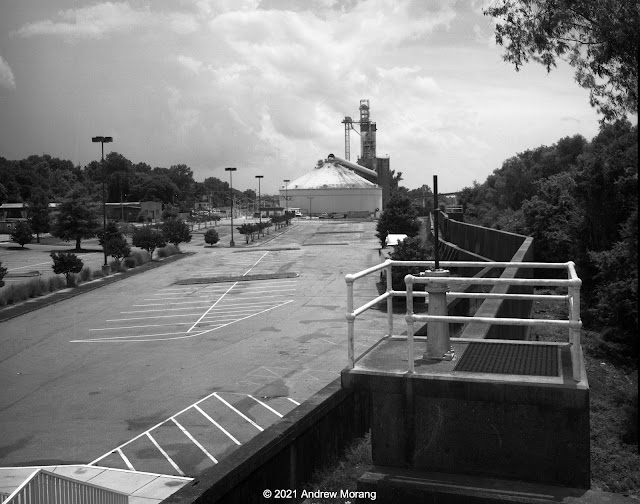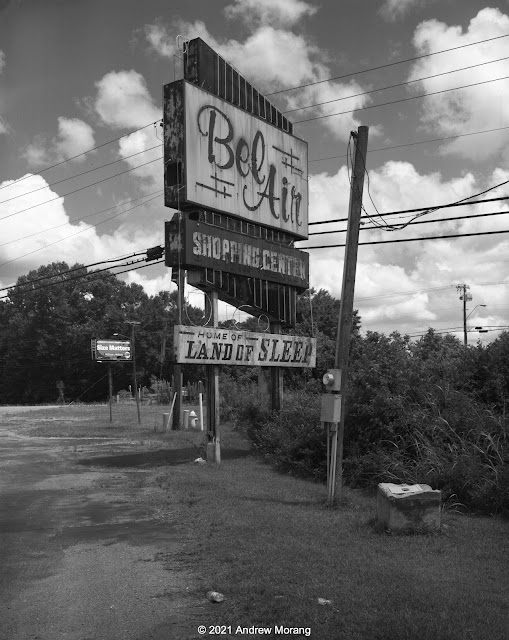Panoramic Cameras
For years I experimented with panoramas. In the past, I took a series of photographs (usually horizontal) with a normal camera and included about 25 percent overlap on each frame. Then I mounted prints on a long board and made a physical panorama. This worked best with 50mm or longer lenses because they did not suffer from distortion or light fall-off at the edges.
More recently, I have scanned the negatives and merged them electronically using Adobe Photoshop. The software is amazingly effective, and often you barely see the junctions where the negatives overlap at all. The quality of the merge depends on whether the lens displays darkening or unsharp areas at the edge of each frame. Regular readers may remember panoramas from
Lower Manhattan and
Logan Airport in Boston (click the links).
For a century, camera makers invented various types of cameras that exposed a wide piece of film. That way, you did not need to combine separate pieces of film or glue prints on a board.
There are three main types of panoramic cameras:
- Stationary lens wide body. The camera body holds a wide piece of film and mounts a lens with sufficient coverage to expose the entire frame. Some examples include Former and Schwing's 7×17 and even 12×20 inch banquet cameras. Can you imagine the size of the latter monster? Mid-century, it was more common to use 6×12 and 6×17 bodies that held 120 film. Some of the best are the gorgeous Linhof models. The disadvantage of these wide bodies is that objects at the sides of the frames become elongated. Think of a round ball that becomes stretched along the axis of the film. That is why most photographers do not use wide angle lenses for group portraits - people at the edge look wide.
- Rotating or swing lens cameras. These are ingenious machines. The lens is on a motorized pivot. The film back is curved, and as the lens moves, it paints the image on the film. With this design, objects at the edge do not become elongated.
- 360º rotation camera. The entire camera rotates through a circle while the film moves at the same speed past the lens. One example is the famous Swiss Roundshot. These provide amazing panoramas from mountain tops or cityscapes from towers.
An excellent introduction to this type of photography is: Meechem, Joseph, 1990. Panoramic Photography, Amphoto, New York, 144p.
 |
| Hasselblad XPan camera with 45mm ƒ/4 lens and center filter |
Lens Options
Two other methods let you create panoramas with an ordinary camera.
- An anamorphic lens compresses the image in one direction while leaving the other unchanged. These were developed for cinematography when wide-screen movies became popular (think of Cinemascope). The film remained the normal size. At the cinema, an opposite (or anti-) anamorphic projection lens recreated the wide view that had been filmed on the set or in nature. These lenses were originally spectacularly expensive, but some Chinese companies are selling new version.
- A shift lens can be mounted on any 35mm camera. Take one picture with the lens shifted full to the left, then a second frame full to the right, and merge the frames with Photoshop. I still have an Olympus OM 35mm ƒ/2.8 shift lens. I need to buy an inexpensive body and put the lens back into use.
Between 1998 and 2006, Fujifilm made a spectacular camera, the
TX-1 (and updated it with the TX-2). Hasselblad marketed them in the USA and Canada as the XPan and XPan-2. This camera looks like a modern rangefinder body, but it is wider. The film opening is 24×65 mm, in contrast to the normal 35mm camera, which exposes only 24×36 mm. Fuji made three superb lenses, 30mm, 45mm, and 90mm. The 30mm and 45mm lenses had optional center filters to even the exposure across the frame. With the recent revival in film photography, TX-1s and XPans are highly coveted and seriously expensive (a 3-lens kit complete with the center filters is a third or half the price of a new car).
Willapa Bay and Grays Harbor, Washington
The coast of Washington has two large estuaries or
rias facing the Pacific Ocean. The southern one is Willapa Bay. Grays Harbor (no apostrophe in the name) is a few miles to the north.
In 2004, I spent a few months working in Seattle on an erosion study of Willapa Bay. A friend offered to fly me to the coast, and I rented an XPan from Glazer's Camera. He had a perfect airplane for the trip because the window opened (or maybe it had no window, I can't remember).
 |
| Mouth of Willapa Bay, view west to the Pacific Ocean |
Willapa Bay faces the Pacific Ocean. Most of the bay is protected from the open ocean by the Long Beach Peninsula, a long sand spit composed of sediment brought down to the ocean by the Colombia River. The mouth of Willapa Bay has been very dynamic and has migrated north more than a kilometer in a century. This northward migration threatened the formerly-protected shellfish grounds used by the Shoalwater Bay Tribe and threatened their homes.
In 1866, President Andrew Johnson created the 334-acre Shoalwater Reserve for the Willapa Bay Chinook people under the
Treaty of Olympia. During the 1990s and 2000s, the village occupied by the tribe (lower right in the photograph above) suffered wave action and threat of severe erosion. The US Army Corps of Engineers conducted a study of hydrodynamics, sediment movement, and geology to evaluate if they could protect the village. If you are interested,
Appendix 1, Engineering Analysis and Design of the 2009 study titled, "Shoalwater Bay Shoreline Erosion, Washington, FLOOD AND COASTAL STORM DAMAGE REDUCTION, Shoalwater Bay Indian Reservation" describes the data and analyses used in the study (full disclosure, I was the author).
Heading north,
Grays Harbor is another large estuary with a dangerous Pacific Ocean mouth. This bay was historically important for the fur trade, fishing, and the timber industry.
 |
| Timber yard, Aberdeen |
Grays Harbor's largest city is Aberdeen, located at the east end of the bay at the mouth of the Chehalis River. During the early 20th century, Aberdeen was the world's largest timber port. Much of the timber today is shipped to Asia.
Olympia
 |
| Washington State capitol, Olympia |
Olympia, in Thurston County, is the capital of Washington State. The marble dome of
Capitol building is said to be the fifth highest masonry dome in the world. This a nice mid-size city, without the congestion and frenetic pace of Seattle, which is about two hours to the northeast. Olympia has a famous
Farmers' Market, where you can indulge your wishes for a gastronomic overload of locally-sourced healthy vegetables and fruits.
Tacoma
Tacoma is an industrial city at the south end of Puget Sound, about an hour south of Seattle. In the 1970s, Tacoma had major steel and paper mills. When the wind blew from the south, we smelled it in Seattle and called it "Aroma of Tacoma." Today, Tacoma has gentrified but remains a major port handling timber, bulk cargoes, petroleum products, and automobiles.
 |
| Tacoma harbor, view west |
 |
| Fisherman cottage, Tacoma (look out for the tsunami) |
What a nice place for a cottage: view of the sea, clang on the buoys, swish of the waves, salty/briny smell of the intertidal flats. But when the
Cascadia subduction zone finally has a big slip, the tsunami will rush into Puget Sound and wash away this little cottage.
 |
| Browns Point, NE Tacoma |
Browns Point has some nice residences on the bluff top and along the base. I do not know about geotechnical issues for the residents at the top with a view. Still, it would be nice.
 |
| Port of Tacoma |
Want a car? Take you pick, all the finest from Japan and Germany.
Stand by for panoramas from Seattle in a future article. Please click any photograph to expand it.


































